|
A Brief History
Designed in collaboration with the Soviet Union, the 3.7 cm Pak L/45 was arguably the best anti-tank gun in the world at the time of its
introduction in 1928. Originally designed for horse drawn transport it was upgraded in the early 1930's to accommodate towing by vehicles with the use of a
sprung suspension and pneumatic tires and re-designated the 3.7cm Pak 35/36.
For their part of the collaboration the Germans assisted the Soviets who were having trouble developing an anti-tank gun on their own. Pre-production guns,
documents and parts
were supplied to the Soviets to use in developing their own versions of the gun. As a result the Soviet's initial gun, the 37mm anti-tank gun Model 1930, was
identical to the German gun. As Soviet manufacturing progressed the gun was upgraded to a larger calibre of 45mm with a slightly longer barrel plus a sprung suspension
for vehicle towing. The ultimate 1942 model of the 45mm gun had a much longer barrel at 68 calibres, about half again as long as the initial guns.
At the time of the German invasion of
the Soviet Union in 1941 both nations had large numbers of these related guns in their inventory as their primary anti-tank weapon. As the war progressed
each side quickly realized that the original design, a world leader when first introduced, was now totally inadequate for its role as a tank killer. Consequently newer,
more powerful guns were developed to deal with tanks, leaving the original gun design to be adapted for other uses.
The Germans modified it into the 4.2cm Pak 41, a squeeze bore gun that was not much more improved over the 3.7cm Pak 35/36 and produced in limited numbers. Later the
carriage was developed for a series of rocket launchers, the 15cm Nebelwerfer 41 & 21cm Nebelwerfer 42, and a large calibre infantry
support gun, the 7.5cm IG 37. On the Soviet side they also produced a large calibre infantry support gun, the 75mm Regimental Gun Model 1943.
| 3.7cm Pak 35/36 - salient traits (for comparison with the Soviet guns below) |
Wood spoked wheels on
initial production guns
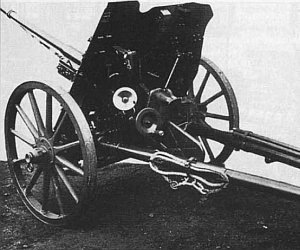 |
The shield face and the
pneumatic tires on later production guns
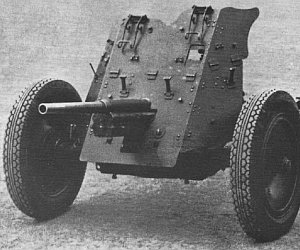 |
Torsion suspension on
later production guns
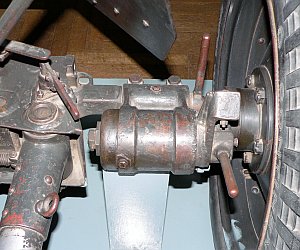 |
No reinforcing on the trail legs
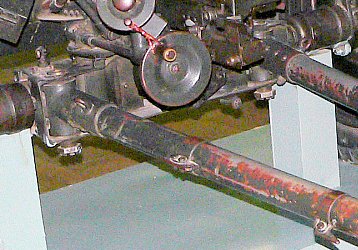 |
| Related Soviet guns - salient traits |
| 45-mm Anti-tank Gun Model 1932: Reference Pictures |
Walk-around Links |
This gun is much the same as the initial versions of the 37mm Anti-tank Gun Model 1930 with the wooden
spoked wheels designed for horse drawn towing. The only major difference visually comes in the form
of a new longer barrel with the distinctive flare at the end and the vertical sliding breech block.
Identification points
- Wood spoked wheels.
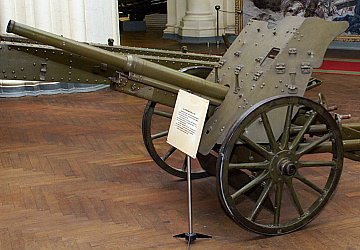
- The axle is solid and not sprung. There is no reinforcing on the trail legs nor on the breech block.
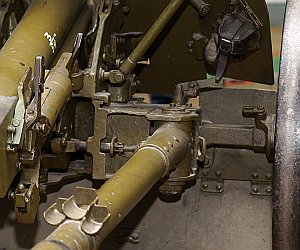
- The shield looks identical to that of the 3.7cm Pak 35/36 with its hinged, forward foldable upper panels
and foldable rests for those panels to lie on (refer to above 3.7cm Pak35/36 shield).
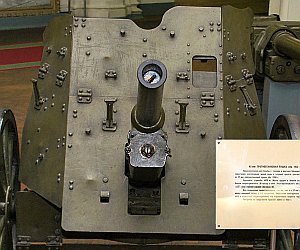
- Short barrel.
|
[1] DishModels.ru
|
| 45-mm Anti-tank Gun Model 1937: Reference Pictures |
Walk-around Links |
This is the Model 1932 gun modified for vehicle towing. Like the German modifications to their 3.7cm Pak 36,
this gun has a torsion bar suspension with pneumatic tires.
Identification points
- Tires usually mounted on wire spoked rims
(reference 12 below has photos of the Model 1937 & Model 1942 guns with
spoked and slotted dish rims).
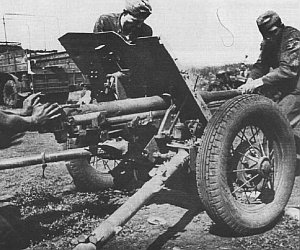
- Torsion bar axle. There is no reinforcing on trail legs nor on the breech block.
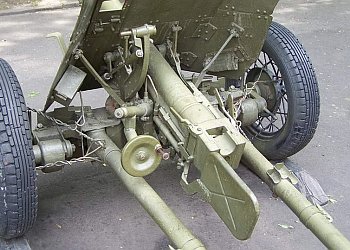
- The shield still retains that similar look of the 3.7cm Pak 35/36 with the hinged, forward foldable
upper panels, but it has been modified, replacing the hinged rests with fixed rests for the panels to lie on
(refer to above 3.7cm Pak35/36 shield).
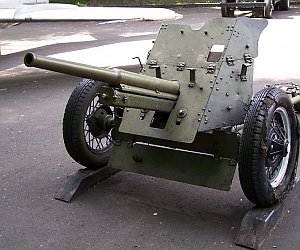
(Note: it appears that later production versions of this gun featured a simplified shield with
reduced scalloping as seen below)
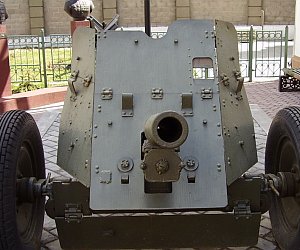
- Short barrel as on Model 1932 gun.
|
[1] DishModels.ru
[2] DishModels.ru
[3] DishModels.ru
|
| 45-mm Anti-tank Gun Model 1942: Reference Pictures |
Walk-around Links |
The major visual difference over the Model 1932 and Model 1937 guns comes with the extended barrel to
increase muzzle velocity and improve armour penetration.
Identification points
- Retains the torsion bar axle. The trail legs are reinforced as is the breech.
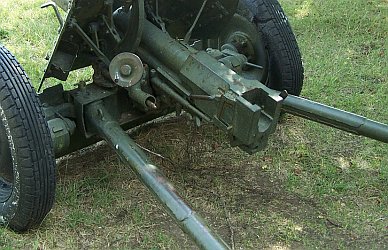
- Retains the same shield as on the Model 1937 gun with hinged forward foldable upper panels
and fixed rests for the panels to lie on
(refer to above 3.7cm Pak35/36 shield)
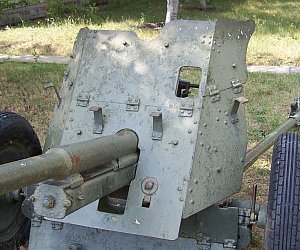
- New long barrel.
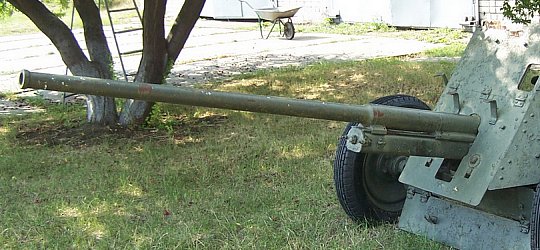
|
[1] DishModels.ru
[2] DishModels.ru
[3] DishModels.ru
[4] DishModels.ru
|
| 76-mm Regimental Gun Model 1943: Reference Pictures |
Walk-around Links |
Like the Germans the Soviets fielded new gun designs utilizing components from older models. This gun used
the barrel from the 76mm Regimental Gun Model 1927 with the carriage from the 45mm Anti-tank Gun Model 1942.
Identification points
- Torsion bar axle.
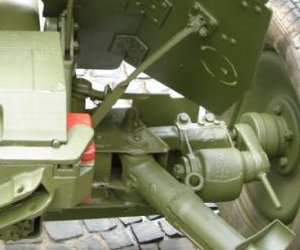
- New 76mm gun barrel taken from the Model 1927 gun.
The shield still has a resemblance to the 3.7cm Pak 35/36 shield though the scalloping is much reduced
and there is a slidable panel on the left side for the sights. The hinges and the fixed rest are present
but I'm not sure if the upper panels can still be folded down as with the previous guns
(refer to above 3.7cm Pak35/36 shield). Retains the reinforced trail legs like those of the
45mm Anti-tank
Gun Model 1942.
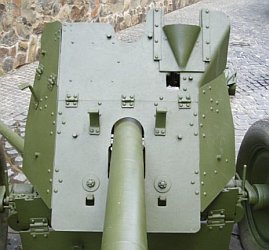
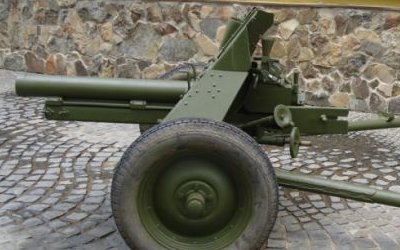
|
[1] DishModels.ru
[2] fotovalkirumodelism.com
|
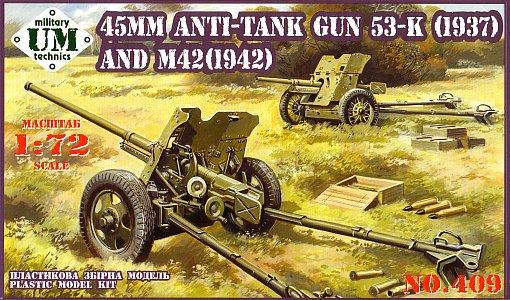
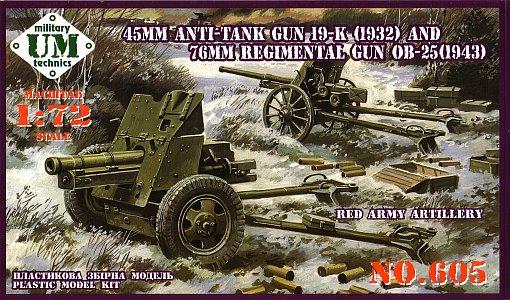
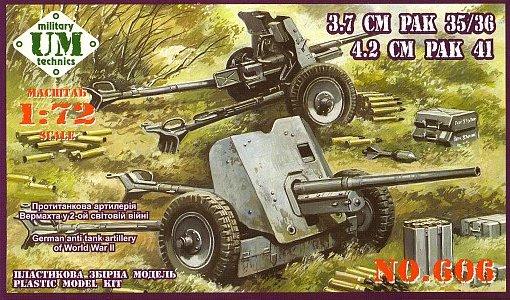
|
The Kits
Now that we've examined the various Soviet guns and their German ancestor, I'd like to look at the UMmt offerings of these guns. Three releases are available with
two guns per box: kit 606
containing the German 3.7cm PaK 35/36 & 4.2cm PaK 41, kit 409 containing the 45mm Anti-tank Gun Model 1937 & 45mm Anti-tank Gun Model 1942, and kit 605 with the
45mm Anti-tank Gun Model 1932 & 76mm Regimental Gun Model 1943.
As you can see the guns all have a strong family resemblance, which UMmt has obviously recognized as an opportunity to release a set of guns
without too much effort above that required for a single gun version. You can see that they tried to get the maximum use from their sprue design. In all the kits
the sprue is labeled UM409A and the parts contained on them
are pretty much identical though they do differ slightly from kit to kit, mostly with regards
to wheel options.
The one item they all do have in common is the trail legs which is the biggest accuracy issue for all the versions. The legs have the extra
bracing, represented as a simple widening of the leg diameter, which is
not valid for either of the German PaK guns, nor for the Model 1932 and Model 1937 versions of the 45mm Soviet anti-tank gun. If the builder keeps the reinforcing a
notch should be scraped along its length on both sides of the leg to more accurately represent the way this reinforcing was actually applied to the legs as separate top and
bottom stips of metal welded in place.
An etched metal shield is employed for all the kits. I assume this was done to simplify production and save costs since the majority of the guns use a similar shield.
As it comes out of the box, the shield is built up of two layers; a full sized part and six smaller pieces to be glued to the face of the larger part. Apart from the issues this
approach causes, seams left at the joins of the smaller parts and the depression that runs around the perimeter of the shield, all of which will need filling,
there is a more egregious error with the small tabs pointed to by the black arrows in the photo below.
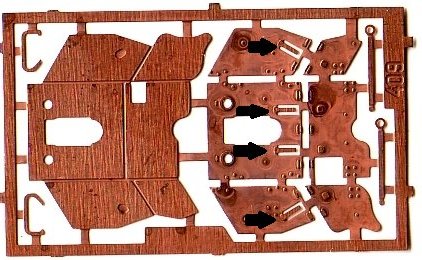
The instructions direct the builder to fold them forward at 45° to represent the fixed rests, but doing so will
leave a depression behind them (due to the shield's layered construction) that isn't found on the shield of any of the real guns.
Fixing this will be awkward. Nearly as bad is the rear of the
shield being totally void of detail. All in all, I feel that the choice of etched metal for the shield was a poor design choice by UMmt.
The commonality of parts also rears its ugly head in regard to the breech. UMmt have used the longer reinforced breech of the 45mm Anti-tank Gun Model 1942 for all
of the Soviet anti-tank kits. The breech for the Model 1932 and Model 1937 should be much shorter, like that supplied in their German Pak 35/36 kit.
For me this is a serious error of judgement on UMmt's part doing this.
Another thing to watch for is the sprung suspension, again common to all kits, but which shouldn't be used for the Model 1932 gun with its solid axle. The builder
will need to modify the kit part accordingly.
|
The German Guns (kit 606)
UMmt have done marginally better with the 3.7cm Pak 35/36 & 4.2cm Pak 41. Because of the common parts the reinforced trail legs as found in the Soviet
gun kits are included and are totally incorrect for the German guns. Needless to say these legs need to be modified. The Pak 35/36 has an acceptable breech which could be used as a replacement
for the breech on the Soviet 45mm guns if it is
cut from the barrel and flipped to represent a vertical block used by the Soviets. The Pak 41, which employed a layered shield, has the outer shield supplied as an
etched piece, but is missing the inner shield. I suppose one could rectify this by taking the Pak 35/36 shield and mounting it behind the Pak 41 shield, though
I think this will not work too well as the Pak 35/36 shield looks to be larger than the Pak 41 shield and the scalloped edges of the Pak 35/36 shield may stick out from behind
the Pak 41 shield. Of course using the Pak 35/36 shield for this purpose would then leave the Pak 35/36 minus its shield. So what it boils down to is that with
this kit, the modeller can build either the Pak 35/36 or Pak 41, but not both. An alternative is to kitbash the UMmt Pak 41 with the dragon Pak 35/36 as I have done
here.
Conclusion
Out of the two sets for the Soviet guns only the 45mm Anti-tank Gun Model 1942 (from kit 409) and the 76mm Regimental Gun Model 1943 (from kit 605)
can be accurately built from the box. To build an accurate Anti-tank Gun Model 1932 or Model 1937 modifications will be needed to remove the reinforcing on the trail
legs, correct the breech and for the Model 1932 gun, convert the suspension to use a solid axle.
Sample kits purchased by the author.
Other References
[1] German Anti-Tank Guns 1939-1945, T.J.Gander, Almark Publications, New Malden, England 1973 ISBN: 0 85524 142 X
[2] Panzerabwehrgeschutze 3,7cm-5,0cm-7,7cm-8,0cm-Pak 1934-1945, Waffen Arsenal Band 117, Pozdun-Pallas-Verlag, Friedberg 1989 ISBN: 3-7909-0360-4
[3] Antitank Artillery of the Wehrmacht 1939-45, Maxim Kolomiets, MK Strategy, Moscow, Russia 2006 ISBN: 5-901266-01-3
[4] wikipedia (PaK 36)
[5] primeportal.net (PaK 35/36 walk around)
[6] wikipedia (76mm Regimental Gun Model 1943)
[7] Silicon Valley Scale Modelers (PaK 35/36 walkaround)
[8] wikipedia (37mm Anti-tank Gun Model 1930)
[9] wikipedia (45mm Anti-tank Gun Model 1937)
[10] wikipedia (45mm Anti-tank Gun Model 1942)
[11] missing-lynx Allied discussion board
[12] wio.ru (various Soviet 45mm Anti-tank gun pictures)
|